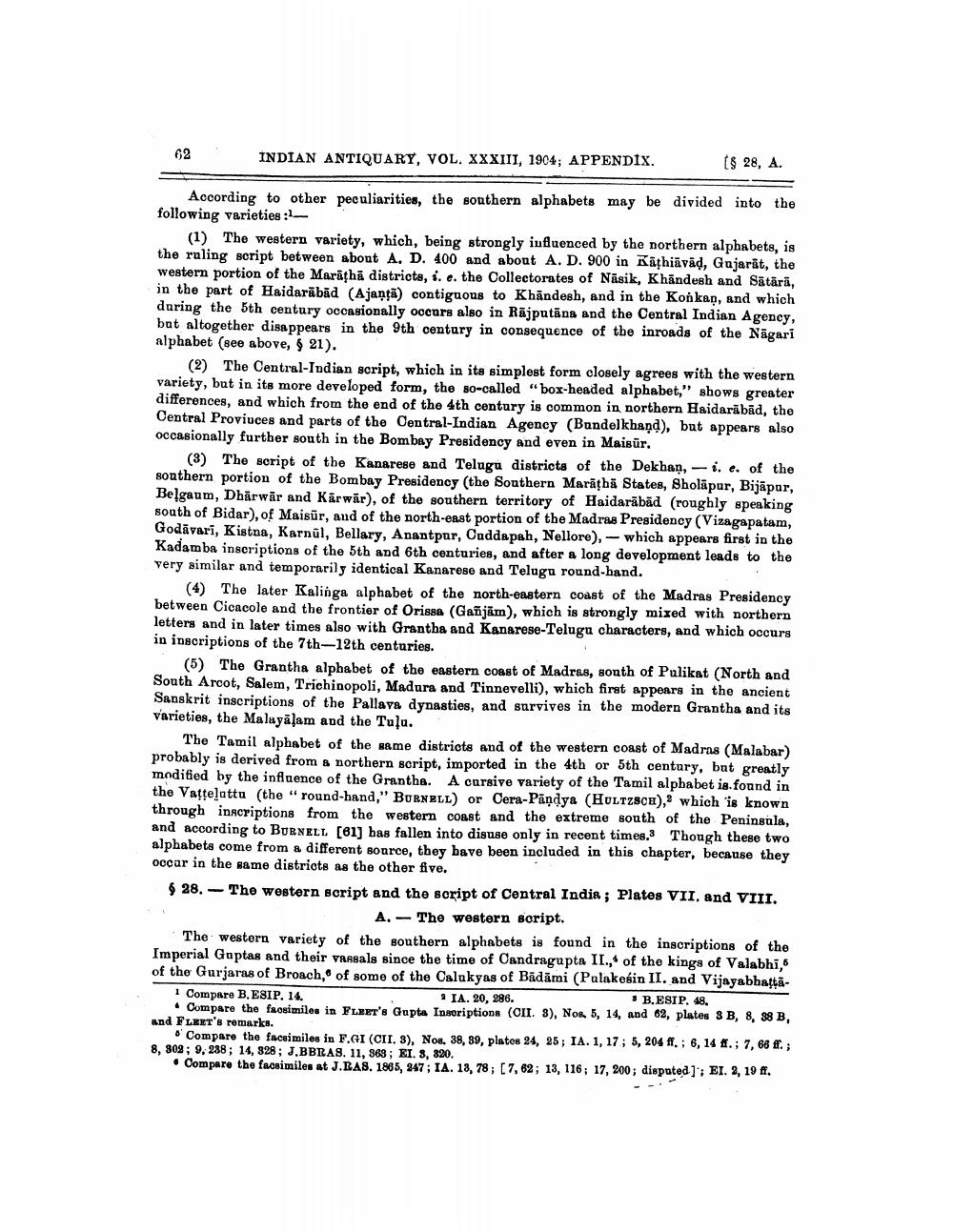________________
62
'
INDIAN ANTIQUARY, VOL. XXXIII, 1904; APPENDIX.
($ 28, A.
According to other peculiarities, the southern alphabets may be divided into the following varieties :
(1) The western variety, which, being strongly influenced by the northern alphabets, is the ruling script between about A. D. 400 and about A. D. 900 in Kathiāvād, Gujarāt, the western portion of the Marathā districts, i. e. the Collectorates of Nāsik, Khandesh and Sātārā, in the part of Haidarābād (Ajantā) contiguous to Khandesh, and in the Konkan, and which during the 5th century occasionally occurs also in Rājputāna and the Central Indian Agency, but altogether disappears in the 9th century in consequence of the inroads of the Nägari Alphabet (see above, 21).
(2) The Central Indian script, which in its simplest form closely agrees with the western variety, but in its more developed form, the so-called "box-headed alphabet," shows greater differences, and which from the end of the 4th century is common in northern Haidarābād, the Central Proviuces and parts of the Central Indian Agency (Bundelkhand), but appears also occasionally further south in the Bombay Presidency and even in Maisūr.
(3) The script of the Kanarese and Telugu districts of the Dekhan, - 1. e. of the southern portion of the Bombay Presidency (the Southern Marathi States, Sholapur, Bijāpar, Belgaum, Dharwār and Kärwar), of the southern territory of Haidarābād (roughly speaking south of Bidar), of Maisūr, and of the north-east portion of the Madras Presidency (Vizagapatam, Godāvari, Kistna, Karnūl, Bellary, Anantpur, Caddapah, Nellore), - which appears first in the Kadamba inscriptions of the 5th and 6th centuries, and after a long development leads to the very similar and temporarily identical Kanarese and Telugu round-band.
(4) The later Kalinga alphabet of the north-eastern coast of the Madras Presidency between Cicacole and the frontier of Orissa (Gañjäm), which is strongly mixed with northern letters and in later times also with Grantha and Kanarese-Telugu characters, and which occurs in inscriptions of the 7th-12th centuries.
(5) The Grantha alphabet of the eastern coast of Madras, south of Palikat (North and South Arcot, Salem, Trichinopoli, Madura and Tinnevelli), which first appears in the ancient Sanskrit inscriptions of the Pallava dynasties, and survives in the modern Grantha and its varieties, the Malayalam and the Tulu.
The Tamil alphabet of the name districts and of the western coast of Madras (Malabar) probably is derived from a northern script, imported in the 4th or 5th century, but greatly modified by the influence of the Grantha. A carsive variety of the Tamil alphabet is found in the Vattelatta (the “round-hand," BURNELL) or Cera-Pāņdya (HULTZSCH), which is known through inscriptions from the western coast and the extreme south of the Peninsula, and according to BURNELL (81) has fallen into disuse only in recent times. Though these two alphabets come from a different source, they have been included in this chapter, because they oocar in the same districts as the other five. 28. - The western script and the script of Central India; Plates VII, and VIII.
A. - The western script. The western variety of the southern alphabets is found in the inscriptions of the Imperial Guptas and their Vaasals since the time of Candragupta IL, of the kings of Valabhi, of the Gurjaras of Broach, of some of the Calukyas of Bādāmi (Palakesin II. and Vijayabhatta1 Compare B.ESIP, 14.
IA. 20, 286.
3 BESIP. 48. . Compare the facsimiles in FLEET's Gupta Insoriptions (CII. S), Nos. 5, 14, and 62, plates 8 B, 8, 38 B, and FLEET's remarks.
Compare the facsimiles in F.GI (CII. 3), No. 38, 39, platos 24, 25; IA. 1, 17; 5, 204 ff.; 6, 14 ff.; 7,68 ff.; 8, 802; 9, 238; 14, 828 ; J.BBRAS. 11, 368; EI. 3, 320.
• Compare the facsimiles at J.BAS. 1865, 347; IA. 18, 78; (7,62; 13, 116; 17, 200; disputed]': EI. 2,19 ff,




